16.01 Gametes and Reproduction
Definition of Sexual Reproduction
- Sexual Reproduction is a biological process that involves the production and fusion of specialized sex cells known as gametes to form a zygote, which subsequently develops into a new organism.
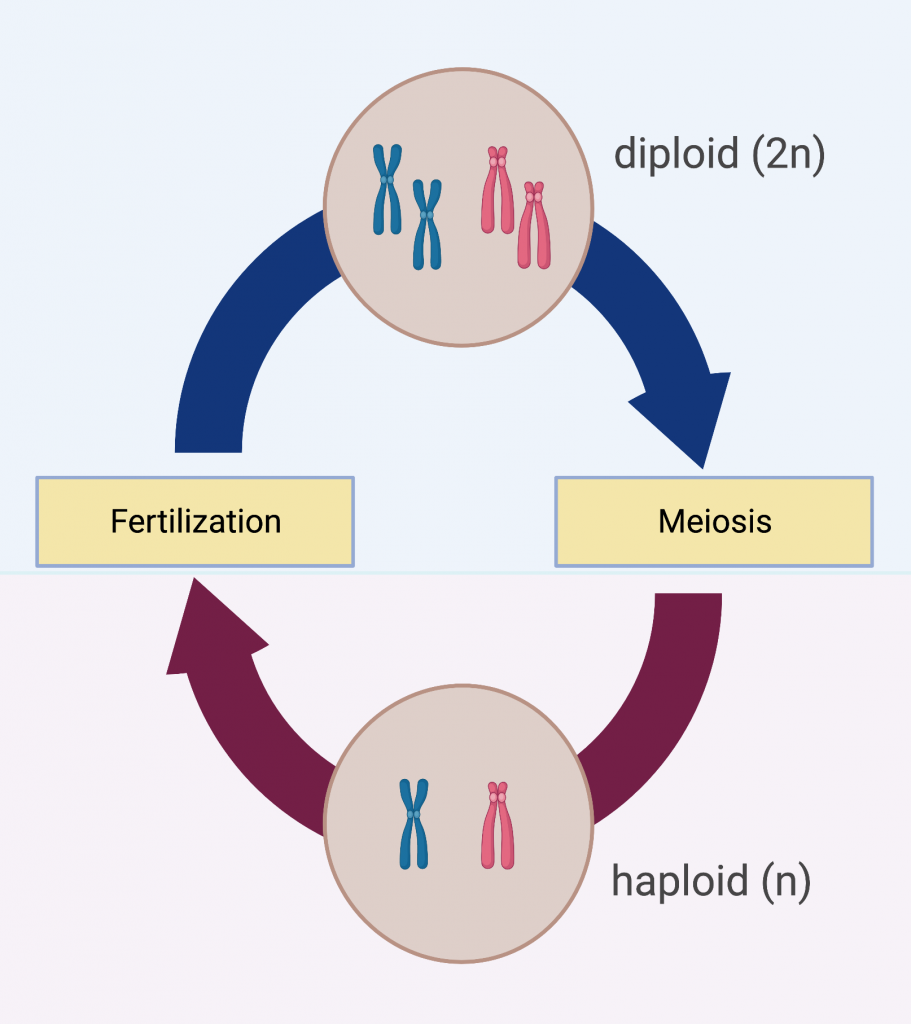
- Key Characteristics:
- Combination of Genetic Material: Involves the merging of genetic information from two parents.
- Genetic Diversity: Promotes variation within a population, enhancing adaptability and evolution.
Examples:
- Humans: Utilize sperm and egg cells for reproduction.
- Animals: Such as cats, dogs, and birds.
- Plants: Many flowering plants reproduce sexually through pollen (male gamete) and ovules (female gamete).
Process of Sexual Reproduction
1.Formation of Gametes (Gamogenesis)
- Males: Produce sperm cells via spermatogenesis.
- Females: Produce egg cells via oogenesis.
- Meiosis: Both processes involve meiosis, a type of cell division that reduces the chromosome number by half, resulting in haploid gametes.
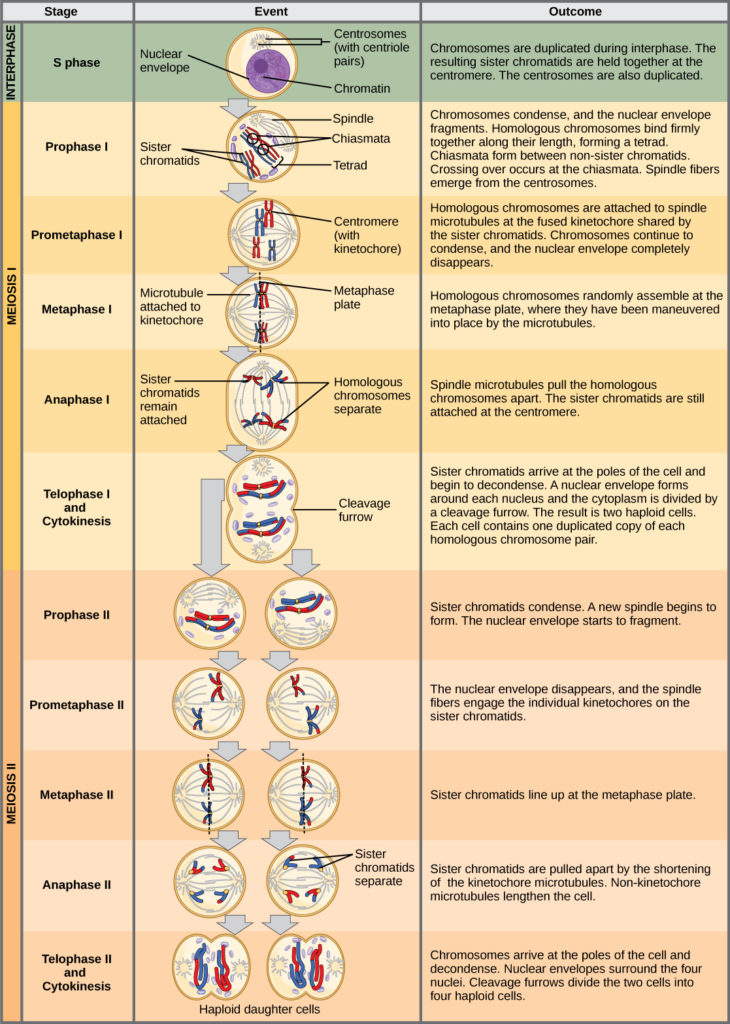
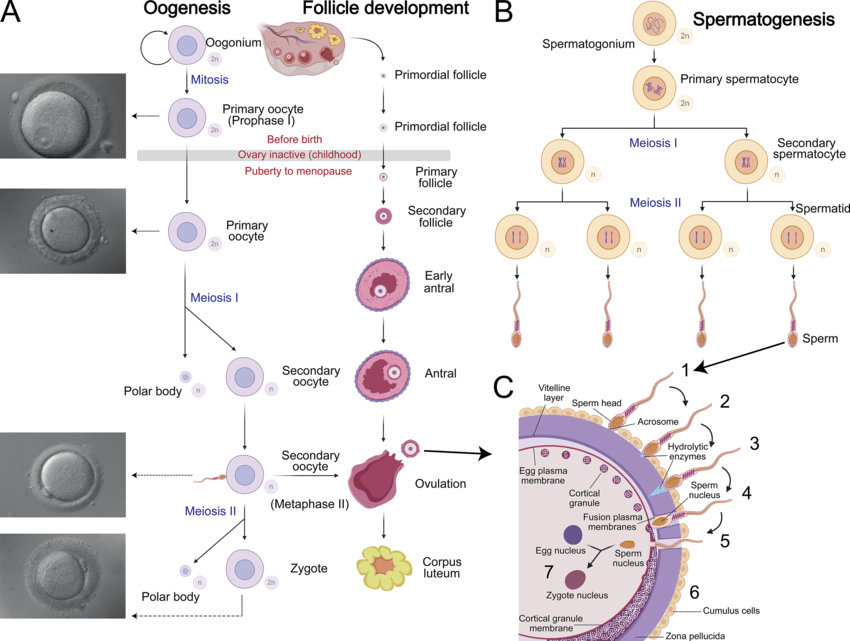
2. Gamete Fusion (Fertilisation)
- Definition: The merging of two haploid gametes (sperm and egg) to form a diploid zygote.
- Mechanism:
- Recognition and Binding: Sperm recognises and binds to the egg.
- Penetration: Sperm penetrates the egg’s protective layers.
- Combination of Nuclei: The nuclei of the sperm and egg merge, combining their genetic material.
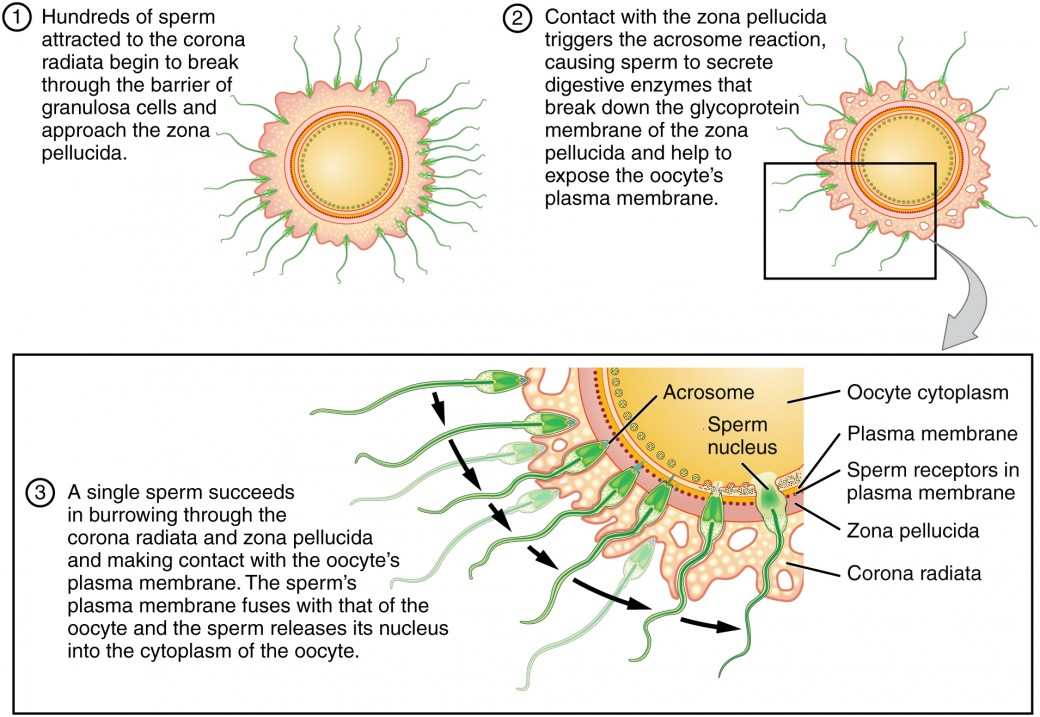
3. Zygote Development
- Initial Cell: The zygote is the first cell of the new organism.
- Mitosis: The zygote undergoes repeated mitotic divisions to develop into a multicellular organism.
- Growth and Differentiation: Cells differentiate to form various tissues and organs.
Figure A: Diagram of Sexual Reproduction Process
- Components: Gamete formation, fertilisation, zygote formation, and embryonic development.
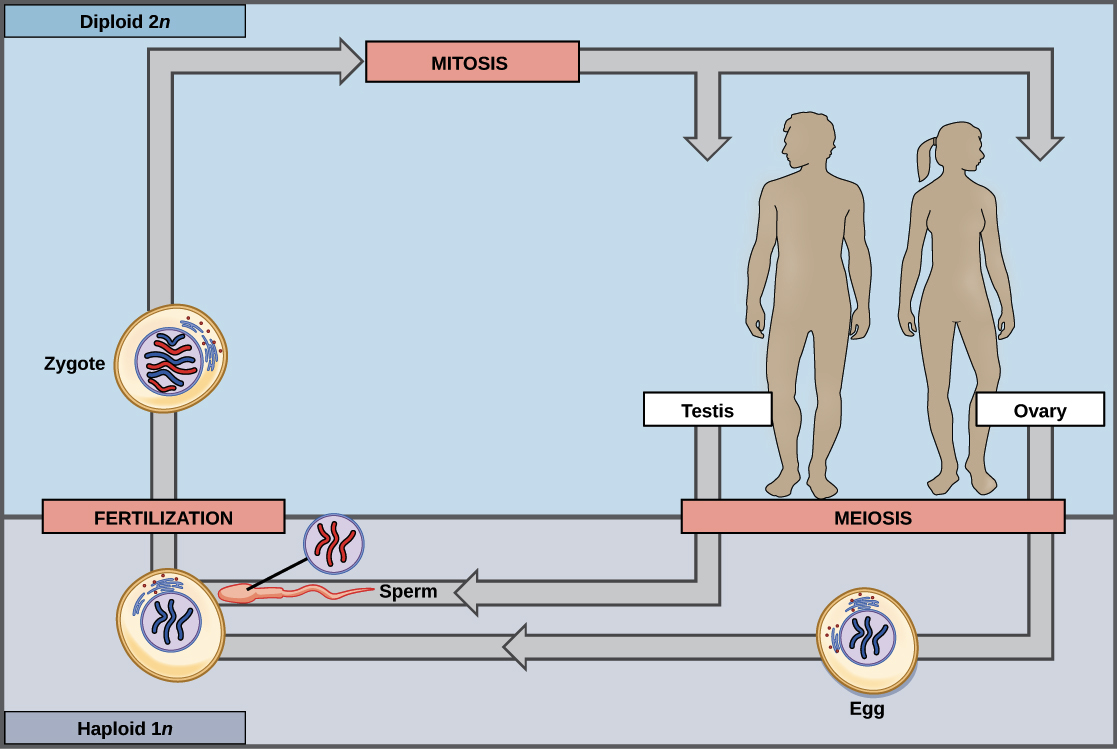
Genetic Basis of Reproduction
1.DNA and Chromosomes
- DNA (Deoxyribonucleic Acid): The molecule that carries genetic instructions for the development, functioning, and reproduction of all living organisms.
- Chromosomes: Structures within cells that contain DNA. Humans have 23 pairs of chromosomes.
- Genes: Segments of DNA located on chromosomes that code for specific proteins or traits.
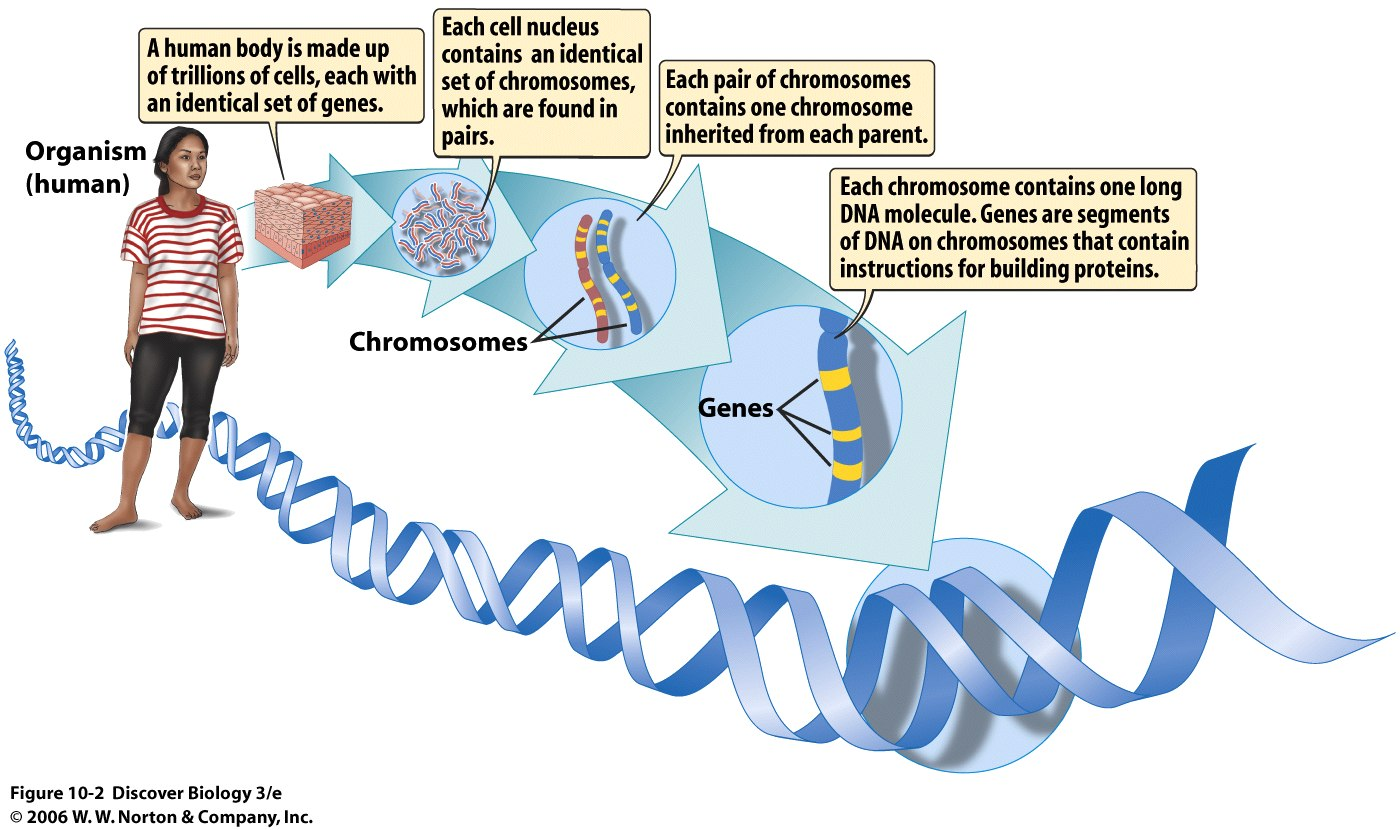
2. Genetic Instructions
- Protein Synthesis: Genes provide the instructions for synthesizing proteins, which perform various functions in the body.
- Inheritance: Offspring inherit genes from both parents, contributing to their unique genetic makeup.
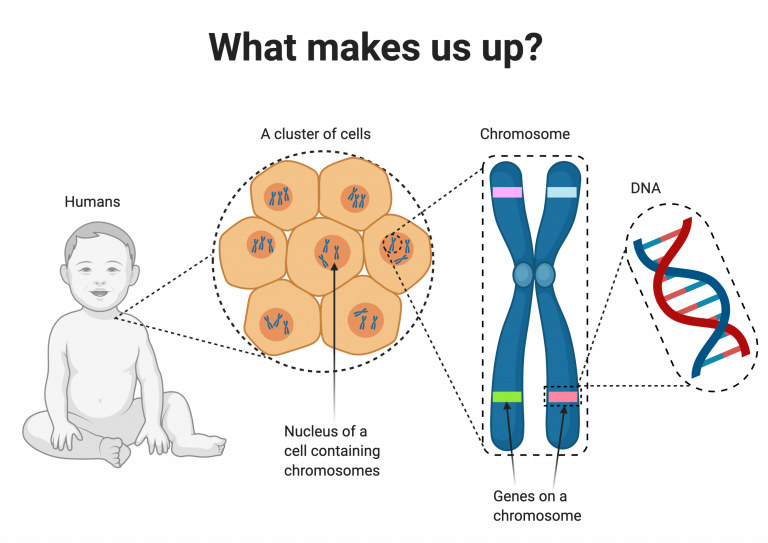
3. Mitosis vs. Sexual Reproduction
| Aspect | Mitosis | Sexual Reproduction |
|---|---|---|
| Purpose | Growth, repair, asexual reproduction | Production of offspring with genetic diversity |
| Cell Division Type | Mitosis | Meiosis followed by fertilisation |
| Genetic Variation | None (genetically identical cells) | High (due to recombination and independent assortment) |
| Number of Cells Produced | Two identical diploid cells | Four genetically unique haploid gametes |
| Chromosome Number | Maintains the same as parent cell (diploid) | Halves the chromosome number (haploid) |
- Mitosis: Ensures each daughter cell receives an identical set of genes, maintaining genetic consistency in asexual reproduction.
- Sexual Reproduction: Involves genetic recombination through meiosis and fertilisation, leading to genetic diversity in offspring.
Figure B: Comparison of Mitosis and Meiosis
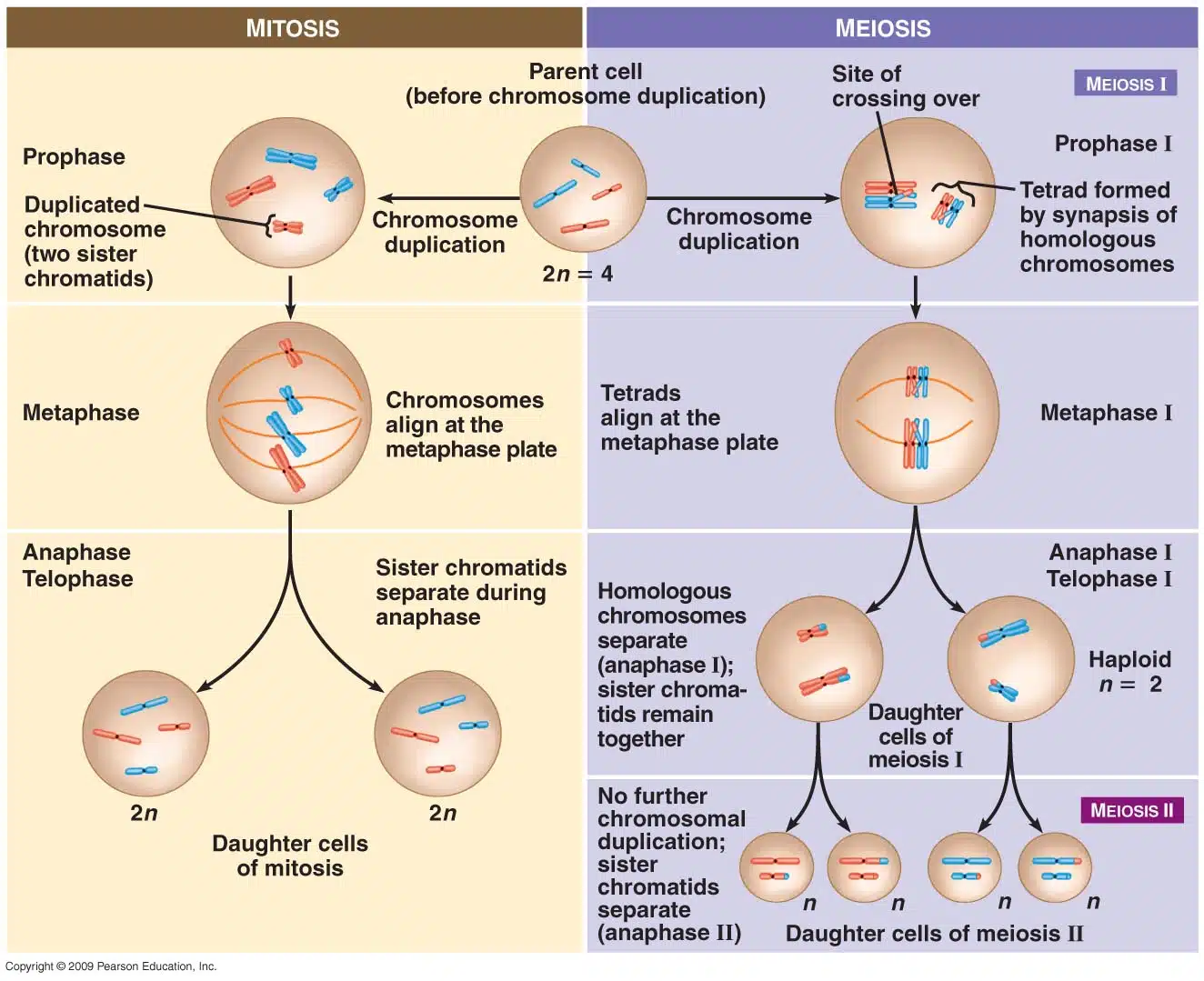
Advantages of Sexual Reproduction
- Genetic Diversity
- Adaptability: Populations with greater genetic diversity are better equipped to adapt to changing environments.
- Disease Resistance: Increased variation can reduce susceptibility to diseases.
- Elimination of Harmful Mutations
- Recombination: Sexual reproduction can help eliminate deleterious mutations from a population over generations.
- Evolutionary Benefits
- Natural Selection: Genetic variation provides the raw material for natural selection to act upon, driving evolution.
Disadvantages of Sexual Reproduction
- Energy and Time Consumption
- Complex Process: Requires more energy and time compared to asexual reproduction.
- Finding Mates: Organisms often invest significant resources in finding and attracting mates.
- Less Reproductive Output
- Single Offspring: Typically produces fewer offspring at a time compared to asexual reproduction.
- Dependency on Two Parents
- Reproductive Success: Relies on the successful union of two gametes, which may not always occur.
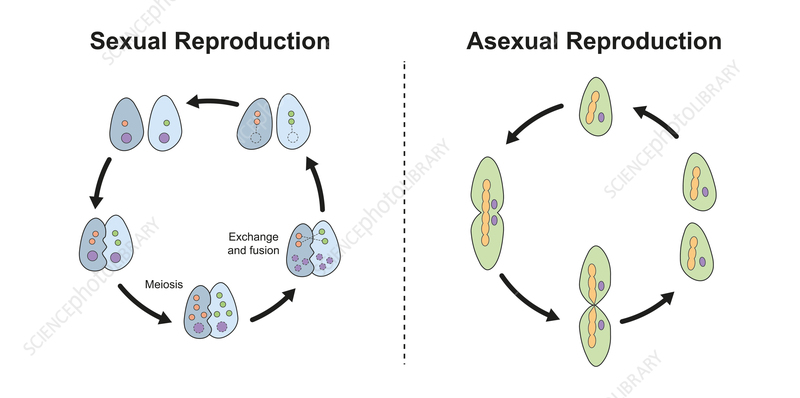
Key Terms Summary
- Sexual Reproduction: Fusion of male and female gametes to form a zygote.
- Asexual reproduction is a type of reproduction that involves a single organism producing offspring without the involvement of gametes (sperm and egg). The offspring are genetically identical to the parent, as there is no exchange or mixing of genetic material. Common methods of asexual reproduction include binary fission, budding, fragmentation, and vegetative propagation.
- Gamete: Haploid cell (sperm or egg) involved in sexual reproduction.
- Zygote: Diploid cell resulting from fertilisation, leading to a new organism.
- Meiosis: Cell division that produces haploid gametes, introducing genetic variation.
- Genetic Diversity: Variation in genes within a population, crucial for adaptation and survival.
Example Questions
Compare and Contrast Mitosis and Meiosis
Mitosis
- Purpose
- Growth, tissue repair, and asexual reproduction in some organisms.
- Occurs in somatic (body) cells.
- Number of Cell Divisions
- One round of cell division.
- Number of Daughter Cells
- Produces two genetically identical daughter cells.
- Chromosome Number
- The chromosome number remains the same (diploid → diploid in animals).
- Genetic Variation
- Low; daughter cells are clones of the parent cell (barring random mutations).
Meiosis
- Purpose
- Production of gametes (eggs and sperm in animals, spores in plants).
- Increases genetic diversity.
- Number of Cell Divisions
- Two rounds of cell division: Meiosis I and Meiosis II.
- Number of Daughter Cells
- Produces four genetically distinct daughter cells.
- Chromosome Number
- The chromosome number is halved (diploid → haploid).
- Genetic Variation
- High; due to crossing over (recombination) and independent assortment of chromosomes.
Roles in Reproduction
- Mitosis: Ensures consistency in cell function and genetic material during growth and regeneration.
- Meiosis: Introduces genetic variability in the population and ensures the maintenance of species-specific chromosome numbers across generations.
Study Summary for Mitosis vs. Meiosis
Main Difference: Meiosis leads to haploid, genetically diverse gametes; mitosis leads to diploid, genetically identical daughter cells.
Key Concepts: Chromosome segregation, crossing over (meiosis only), somatic cells vs. gametes.
Importance of Genetic Diversity
How Sexual Reproduction Contributes to Genetic Diversity
- Crossing Over
- During meiosis I, homologous chromosomes exchange segments (recombination), generating new allele combinations.
- Independent Assortment
- Homologous chromosome pairs line up randomly in meiosis I, leading to many possible combinations of chromosomes in gametes.
- Random Fertilization
- Any sperm can fuse with any egg, creating a large number of potential genetic outcomes.
Why Genetic Diversity Is Beneficial
- Adaptation to Changing Environments: A genetically diverse population is more likely to have individuals with advantageous traits that help them survive and reproduce.
- Disease Resistance: Variation in immune system genes can help populations combat a range of pathogens.
- Long-Term Survival: Genetic diversity prevents inbreeding depression and reduces the likelihood of harmful recessive traits becoming widespread.
Study Summary for Genetic Diversity
- Main Outcome: Populations with higher genetic diversity have better resilience and adaptability.
- Key Concepts: Variation arises from mutation, recombination, and random fertilization.
Advantages vs. Disadvantages of Sexual Reproduction
Advantages
- Genetic Diversity
- Sexual reproduction combines DNA from two parents, increasing genetic variation and promoting adaptability.
- Reduced Accumulation of Harmful Mutations
- Recombination and independent assortment can dilute deleterious alleles over generations.
- Better Adaptation to Environmental Changes
- Greater range of phenotypes increases the chance that some offspring can thrive if the environment changes.
Disadvantages
- Requires Two Parents
- Finding a mate can be difficult or risky, particularly in sparse populations or where mate competition is high.
- More Energy and Time
- Courtship, mating behaviors, and parental care (in some species) require significant resources.
- Fewer Offspring in a Given Time
- Compared to asexual reproduction (where offspring can be rapidly produced by a single individual), sexual reproduction often yields fewer total offspring over the same period.
Comparison with Asexual Reproduction
- Asexual Reproduction
- Pros: Rapid reproduction, no need to find a mate, genetically uniform offspring well-suited for stable environments.
- Cons: Low genetic diversity makes the population vulnerable to changes or new diseases.
- Sexual Reproduction
- Pros: High genetic diversity, adaptability.
- Cons: Requires more energy, mate-finding, potentially slower population growth.
Study Summary for Advantages vs. Disadvantages
- Main Consideration: Sexual reproduction excels in changing environments due to diversity, whereas asexual reproduction is efficient but less adaptable.
- Key Concepts: Genetic diversity trade-offs, environmental pressures, population growth strategies.
Practice Questions
Question 1: Define Sexual Reproduction.
Marking Scheme:
Answer: Sexual Reproduction is a biological process that involves the production and fusion of specialized sex cells known as gametes to form a zygote, which subsequently develops into a new organism.
- Definition of Sexual Reproduction (2 marks)
- 1 mark for stating that it is a biological process involving the production and fusion of gametes.
- 1 mark for mentioning that it forms a zygote which develops into a new organism.
Total: 2 Marks
Study Notes: Sexual reproduction combines genetic material from two parents through gametes (sperm and egg), leading to genetic diversity in offspring.
Question 2: List three key characteristics of sexual reproduction and briefly explain each.
Answer:
- Combination of Genetic Material: Involves the merging of genetic information from two parents.
- Genetic Diversity: Promotes variation within a population, enhancing adaptability and evolution.
- Production of Gametes: Specialized sex cells (sperm and egg) are produced through meiosis.
Marking Scheme:
- Three Key Characteristics (3 marks)
- 1 mark for each characteristic listed correctly.
- Explanation of Each Characteristic (3 marks)
- 1 mark for a brief explanation of each characteristic.
Total: 6 Marks
Study Notes:
Production of Gametes: Meiosis reduces chromosome number, ensuring genetic variation.
Combination of Genetic Material: Ensures offspring inherit traits from both parents.
Genetic Diversity: Increases the population’s ability to survive changing environments.
Question 3: Explain the process of meiosis in gamete formation.
Answer: Meiosis is a type of cell division that reduces the chromosome number by half, resulting in haploid gametes. In males, meiosis occurs through spermatogenesis to produce sperm cells. In females, it occurs through oogenesis to produce egg cells. This process involves two successive divisions (Meiosis I and Meiosis II) without an intervening round of DNA replication, ensuring each gamete has half the chromosome number of the parent cell.
Marking Scheme:
- Definition of Meiosis (1 mark)
- Meiosis reduces chromosome number by half to produce haploid gametes.
- Gamete Formation in Males and Females (2 marks)
- 1 mark for spermatogenesis in males producing sperm.
- 1 mark for oogenesis in females producing egg cells.
- Details of the Process (2 marks)
- 1 mark for mentioning Meiosis I and II.
- 1 mark for explaining no DNA replication between divisions, ensuring haploid gametes.
Total: 5 Marks
Study Notes: Meiosis ensures genetic variation through processes like crossing over and independent assortment, which shuffle genetic material during gamete formation.
Question 4: Compare and contrast mitosis and sexual reproduction in terms of genetic variation and chromosome number.
Answer:
- Genetic Variation:
- Mitosis: No genetic variation; produces genetically identical cells.
- Sexual Reproduction: High genetic variation due to recombination and independent assortment during meiosis.
- Chromosome Number:
- Mitosis: Maintains the same chromosome number as the parent cell (diploid).
- Sexual Reproduction: Reduces chromosome number by half in gametes (haploid) through meiosis, which fuse during fertilization to restore diploid number.
Marking Scheme:
- Genetic Variation Comparison (2 marks)
- 1 mark for stating mitosis results in no genetic variation.
- 1 mark for stating sexual reproduction results in high genetic variation.
- Chromosome Number Comparison (2 marks)
- 1 mark for mitosis maintaining diploid number.
- 1 mark for sexual reproduction reducing to haploid and restoring diploid upon fertilization.
Total: 4 Marks
Study Notes: Mitosis is essential for growth and repair, producing identical cells, while sexual reproduction introduces genetic diversity, crucial for evolution and adaptability.
Question 5: Describe the process of fertilisation in sexual reproduction.
Answer: Fertilisation is the merging of two haploid gametes (sperm and egg) to form a diploid zygote. The process involves:
- Recognition and Binding: The sperm recognizes and binds to the egg.
- Penetration: The sperm penetrates the egg’s protective layers.
- Combination of Nuclei: The nuclei of the sperm and egg merge, combining their genetic material to form the zygote.
Marking Scheme:
- Definition of Fertilisation (1 mark)
- Merging of two haploid gametes to form a diploid zygote.
- Steps of Fertilisation (3 marks)
- 1 mark for Recognition and Binding.
- 1 mark for Penetration of egg’s protective layers.
- 1 mark for Combination of nuclei to form zygote.
Total: 4 Marks
Study Notes: Fertilisation restores the diploid chromosome number and initiates the development of a new organism through zygote formation and subsequent cell divisions.
Question 6: Why is genetic diversity important in populations? Provide two reasons.
Answer:
- Adaptability: Genetic diversity enhances a population’s ability to adapt to changing environments, increasing the chances of survival.
- Disease Resistance: Greater genetic variation reduces the likelihood that a disease can affect all individuals, as some may possess resistance.
Marking Scheme:
- First Reason (1 mark)
- Adaptability due to genetic diversity enhancing survival in changing environments.
- Second Reason (1 mark)
- Disease resistance as genetic variation prevents widespread susceptibility.
Total: 2 Marks
Study Notes: Genetic diversity is critical for the resilience of populations, allowing them to withstand environmental pressures and evolve over time.
Question 7: Identify and explain two advantages and two disadvantages of sexual reproduction.
Answer: Advantages:
- Genetic Diversity: Increases variation within a population, enhancing adaptability and evolution.
- Elimination of Harmful Mutations: Recombination can help remove deleterious mutations from the gene pool over generations.
Disadvantages:
- Energy and Time Consumption: Sexual reproduction requires more energy and time compared to asexual reproduction.
- Dependency on Two Parents: Relies on the successful union of two gametes, which may not always occur, reducing reproductive success.
Marking Scheme:
- Advantages (2 marks)
- 1 mark for Genetic Diversity with explanation.
- 1 mark for Elimination of Harmful Mutations with explanation.
- Disadvantages (2 marks)
- 1 mark for Energy and Time Consumption with explanation.
- 1 mark for Dependency on Two Parents with explanation.
Total: 4 Marks
Study Notes: While sexual reproduction fosters genetic variation and helps maintain healthy populations by eliminating harmful genes, it is more resource-intensive and less efficient in producing offspring compared to asexual methods.
Question 8: Match the following key terms with their correct definitions.
| Terms | Definitions |
|---|---|
| 1. Gamete | A. The diploid cell formed by the fusion of two gametes |
| 2. Zygote | B. A haploid sex cell involved in sexual reproduction |
| 3. Meiosis | C. Cell division that produces haploid gametes |
| 4. Genetic Diversity | D. Variation in genetic characteristics within a population |
Answer:
- Gamete – B. A haploid sex cell involved in sexual reproduction
- Zygote – A. The diploid cell formed by the fusion of two gametes
- Meiosis – C. Cell division that produces haploid gametes
- Genetic Diversity – D. Variation in genetic characteristics within a population
Marking Scheme:
- Each correct match (1 mark each)
- 4 terms × 1 mark = 4 marks.
- Incorrect matches receive no marks.
Total: 4 Marks
Study Notes: Understanding key terms is essential for grasping the concepts of sexual reproduction and its implications for genetic variation and inheritance.
Question 9: Explain how sexual reproduction can lead to the elimination of harmful mutations from a population.
Answer: Sexual reproduction involves genetic recombination during meiosis, which can separate harmful mutations from beneficial or neutral genes. When gametes fuse during fertilisation, harmful mutations may be masked by healthy alleles from the other parent. Over successive generations, harmful mutations are less likely to be passed on, as they are eliminated through natural selection, ensuring that individuals with fewer deleterious mutations have higher survival and reproductive success.
Marking Scheme:
- Genetic Recombination (1 mark)
- Recombination during meiosis can separate harmful mutations from other genes.
- Masking of Mutations (1 mark)
- Harmful mutations may be masked by healthy alleles during fertilisation.
- Natural Selection (1 mark)
- Individuals with fewer harmful mutations are more likely to survive and reproduce.
Total: 3 Marks
Study Notes: Sexual reproduction facilitates the removal of harmful genetic variations, contributing to the overall health and viability of populations.
Question 10: Describe the development of a zygote into a multicellular organism.
Answer: After fertilisation, the zygote, which is the initial diploid cell, begins to undergo repeated mitotic divisions in a process called cleavage. These mitotic divisions increase the number of cells without increasing the overall size of the organism. As cell division continues, the cells begin to differentiate, meaning they develop into various types of cells that form different tissues and organs. This growth and differentiation lead to the formation of a multicellular organism, with specialized structures performing specific functions necessary for survival.
Marking Scheme:
- Initial Cell – Zygote (1 mark)
- Zygote is the first cell of the new organism.
- Mitosis (1 mark)
- Repeated mitotic divisions increase the number of cells.
- Growth and Differentiation (2 marks)
- Cells differentiate into various tissues and organs.
- Formation of a multicellular organism with specialized structures.
Total: 4 Marks
Study Notes: The development from a zygote to a multicellular organism involves cell division and differentiation, ensuring that the organism grows and forms the necessary structures for life.